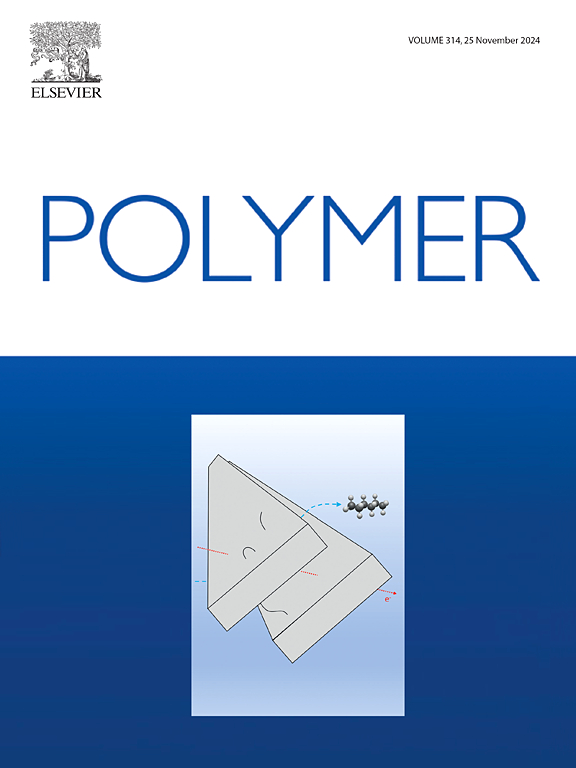Enhancement of mechanical properties of TATB-based polymer bonded explosive by surface grafting polymer brushes
IF 4.1
2区 化学
Q2 POLYMER SCIENCE
引用次数: 0
Abstract
Improving the interfacial interaction between explosive crystals and the polymeric binder was essential for enhancing the mechanical properties of polymer bonded explosives (PBXs). In this study, the surface of the 1,3,5-triamino-2,4,6-trinitrobenzene (TATB) crystal was initially coated with a polydopamine (PDA) layer, which served as an active platform for anchoring the 2-bromoisobutyryl bromide as an ATRP initiator; then, the co-polymer chains composed of Acrylonitrile(AN), 2-Hydroxyethyl methacrylate (HEMA) and 2-(Dimethylamino)ethyl methacrylate (DMAEMA) were grown through surface-initiated atom transfer radical polymerization (SI-ATRP) from the surface of TATB modified with ATRP initiator. The formation of the PDA, ATRP initiator and polymer brush coating layer on the surface of TATB was confirmed through SEM, TEM, XPS and contact angle tests. After incorporating a rigid-flexible gradient interface structure composed of PDA and polymer brush layer, the PBXs exhibited enhanced mechanical strength and creep resistance. Compared with the pristine TATB-based PBXs, the static mechanical properties, including tensile and compressive strength, of TATB@PDA@PAN-co-PHEMA-co-PDMAEMA based PBXs were increased by 36.7% and 23.9%, respectively. The maximum creep strain decreased by 39.4% at 30 °C and 14.6% at 75 °C. Additionally, the coefficient of thermal expansion decreased by 8.37%. This study presents an universal method for enhancing the mechanical properties of PBX by integrating PDA chemistry with SI-ATRP.

通过表面接枝聚合物刷提高基于 TATB 的聚合物粘合炸药的机械性能
改善炸药晶体与聚合物粘合剂之间的界面相互作用对于提高聚合物粘合炸药(PBX)的机械性能至关重要。在这项研究中,1,3,5-三氨基-2,4,6-三硝基苯(TATB)晶体表面最初涂有聚多巴胺(PDA)层,作为锚定作为 ATRP 起始剂的 2-溴异丁酰溴的活性平台;然后,由丙烯腈(AN)、甲基丙烯酸羟乙酯(HEMA)和甲基丙烯酸 2-(二甲基氨基)乙酯(DMAEMA)组成的共聚物链通过表面引发原子转移自由基聚合(SI-ATRP)从经 ATRP 引发剂修饰的 TATB 表面生长出来。通过 SEM、TEM、XPS 和接触角测试证实了 PDA、ATRP 起始剂和聚合物刷涂层在 TATB 表面的形成。在加入由 PDA 和聚合物刷层组成的刚柔梯度界面结构后,PBX 具有更高的机械强度和抗蠕变性。与原始 TATB 基 PBX 相比,TATB@PDA@PAN-co-PHEMA-co-PDMAEMA 基 PBX 的静态力学性能(包括拉伸强度和压缩强度)分别提高了 36.7% 和 23.9%。30 °C 时的最大蠕变应变降低了 39.4%,75 °C 时降低了 14.6%。此外,热膨胀系数降低了 8.37%。本研究提出了一种通过将 PDA 化学与 SI-ATRP 相结合来增强 PBX 力学性能的通用方法。
本文章由计算机程序翻译,如有差异,请以英文原文为准。
求助全文
约1分钟内获得全文
求助全文
来源期刊

Polymer
化学-高分子科学
CiteScore
7.90
自引率
8.70%
发文量
959
审稿时长
32 days
期刊介绍:
Polymer is an interdisciplinary journal dedicated to publishing innovative and significant advances in Polymer Physics, Chemistry and Technology. We welcome submissions on polymer hybrids, nanocomposites, characterisation and self-assembly. Polymer also publishes work on the technological application of polymers in energy and optoelectronics.
The main scope is covered but not limited to the following core areas:
Polymer Materials
Nanocomposites and hybrid nanomaterials
Polymer blends, films, fibres, networks and porous materials
Physical Characterization
Characterisation, modelling and simulation* of molecular and materials properties in bulk, solution, and thin films
Polymer Engineering
Advanced multiscale processing methods
Polymer Synthesis, Modification and Self-assembly
Including designer polymer architectures, mechanisms and kinetics, and supramolecular polymerization
Technological Applications
Polymers for energy generation and storage
Polymer membranes for separation technology
Polymers for opto- and microelectronics.
 求助内容:
求助内容: 应助结果提醒方式:
应助结果提醒方式:


